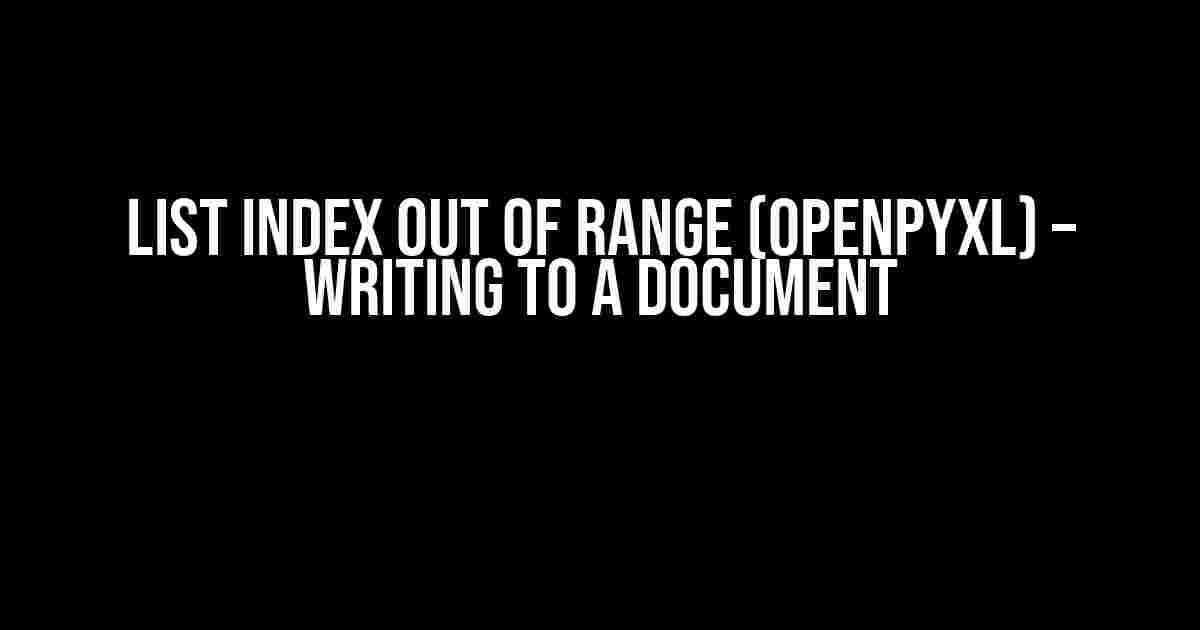Are you tired of encountering the frustrating “List index out of range” error while working with Openpyxl to write to an Excel document? You’re not alone! This error can be a major roadblock, but don’t worry, we’ve got you covered. In this article, we’ll delve into the world of Openpyxl and provide you with a comprehensive guide on how to overcome this error and write to your Excel document with ease.
What is Openpyxl?
Before we dive into the solution, let’s take a step back and understand what Openpyxl is. Openpyxl is a Python library used to read and write Excel files (.xlsx, .xlsm, .xltx, .xltm). It allows you to create, modify, and save Excel files, giving you full control over the formatting, data, and structure of your spreadsheets. Openpyxl is an excellent tool for automating Excel tasks, reporting, and data analysis.
The “List Index Out of Range” Error
The “List index out of range” error occurs when you try to access an element in a list that doesn’t exist. In the context of Openpyxl, this error typically occurs when you’re trying to write to a cell or range of cells, but the index you’re using is beyond the bounds of the worksheet or range.
Causes of the Error
There are several reasons why you might encounter the “List index out of range” error when working with Openpyxl:
-
Invalid worksheet or range selection
-
Incorrect cell or range indexing
-
Unused or empty worksheets or ranges
-
Malformed Excel file or corrupted data
Solving the “List Index Out of Range” Error
Now that we’ve covered the basics, let’s get to the solution! To overcome the “List index out of range” error, follow these steps:
Step 1: Verify Worksheet and Range Selection
Double-check that you’re selecting the correct worksheet and range in your code. Make sure the worksheet exists in the workbook, and the range is valid and not empty.
from openpyxl import load_workbook
# Load the workbook
wb = load_workbook('example.xlsx')
# Select the active worksheet
ws = wb.active
# Verify the worksheet and range
print(ws.title) # Output: Sheet1
print(ws.dimensions) # Output: A1:E10
Step 2: Check Cell and Range Indexing
Ensure that your cell or range indexing is correct. Remember that Openpyxl uses zero-based indexing, meaning the first cell or row is indexed at 0.
from openpyxl import load_workbook
# Load the workbook
wb = load_workbook('example.xlsx')
# Select the active worksheet
ws = wb.active
# Access cell A1
cell = ws['A1']
print(cell.value) # Output: Hello, World!
# Access range A1:B2
range_cells = ws['A1:B2']
for row in range_cells:
for cell in row:
print(cell.value, end=' ')
print()
Step 3: Handle Unused or Empty Worksheets and Ranges
If you’re working with multiple worksheets or ranges, ensure that you’re not trying to access an unused or empty worksheet or range. You can use the `ws.max_row` and `ws.max_column` properties to get the last occupied row and column, respectively.
from openpyxl import load_workbook
# Load the workbook
wb = load_workbook('example.xlsx')
# Select the active worksheet
ws = wb.active
# Get the last occupied row and column
last_row = ws.max_row
last_col = ws.max_column
print(f"Last occupied row: {last_row}")
print(f"Last occupied column: {last_col}")
Step 4: Check for Malformed Excel File or Corrupted Data
In rare cases, a malformed Excel file or corrupted data can cause the “List index out of range” error. Try opening the Excel file manually to check for any Issues. If you’re generating the Excel file programmatically, review your code to ensure that it’s creating a valid Excel file.
Best Practices for Writing to an Excel Document with Openpyxl
To avoid the “List index out of range” error and ensure smooth writing to an Excel document with Openpyxl, follow these best practices:
-
Use the `ws.iter_rows()` and `ws.iter_cols()` methods to iterate over rows and columns, respectively.
-
Use the `ws.cell()` method to access individual cells.
-
Avoid using `ws.rows` and `ws.cols` properties, as they can cause performance issues.
-
Use the `ws.append()` method to add data to the end of a worksheet.
-
Use the `ws.insert_rows()` and `ws.insert_cols()` methods to insert rows and columns, respectively.
Conclusion
In conclusion, the “List index out of range” error can be a frustrating obstacle when working with Openpyxl to write to an Excel document. By following the steps outlined in this article, you’ll be able to identify and resolve the error, ensuring that your Excel automation tasks run smoothly. Remember to verify worksheet and range selection, check cell and range indexing, handle unused or empty worksheets and ranges, and check for malformed Excel files or corrupted data. By adopting best practices and understanding the intricacies of Openpyxl, you’ll be well on your way to becoming an Excel automation master!
| Keyword | Description |
|---|---|
| Openpyxl | A Python library for reading and writing Excel files. |
| List index out of range | An error that occurs when trying to access an element in a list that doesn’t exist. |
| Worksheet | A single sheet within an Excel workbook. |
| Range | A group of cells in an Excel worksheet. |
By the end of this article, you should have a solid understanding of how to overcome the “List index out of range” error when writing to an Excel document with Openpyxl. If you have any further questions or concerns, please don’t hesitate to ask in the comments below.
Frequently Asked Question
Get ready to overcome the hurdle of “List index out of range” when writing to a document using openpyxl!
What causes the “List index out of range” error when writing to a document using openpyxl?
This error occurs when you’re trying to access a cell that doesn’t exist in the worksheet. It’s like trying to find a book on a shelf that hasn’t been built yet! Make sure you’re iterating over the correct range of cells, and that your worksheet has enough rows and columns to accommodate your data.
How can I avoid the “List index out of range” error when writing to a large document using openpyxl?
To avoid this error, use the `max_row` and `max_column` properties to get the total number of rows and columns in your worksheet. Then, iterate over the range of cells using a loop, and access each cell using the `cell` method. This way, you’ll never try to access a cell that doesn’t exist!
What’s the difference between `ws[‘A1’]` and `ws.cell(row=1, column=1)` when writing to a document using openpyxl?
Both methods can be used to access a cell, but `ws[‘A1’]` is more prone to the “List index out of range” error. When you use `ws[‘A1’]`, openpyxl tries to access the cell directly, which can fail if the cell doesn’t exist. On the other hand, `ws.cell(row=1, column=1)` creates a cell object even if it doesn’t exist, which can help you avoid the error.
Can I use `try`-`except` blocks to handle the “List index out of range” error when writing to a document using openpyxl?
Yes, you can use `try`-`except` blocks to catch the `IndexError` exception that’s raised when you encounter a “List index out of range” error. However, it’s often better to avoid the error in the first place by checking the bounds of your worksheet and iterating over the correct range of cells. This way, you can avoid unnecessary exceptions and make your code more efficient!
How can I optimize my code to avoid the “List index out of range” error when writing to a large document using openpyxl?
To optimize your code, use openpyxl’s `iter_rows` and `iter_cols` methods to iterate over the rows and columns of your worksheet. These methods are more memory-efficient than iterating over the entire worksheet, and they can help you avoid the “List index out of range” error. Additionally, consider using `pandas` to manipulate your data before writing it to the worksheet, as it provides more efficient data structures and operations.








